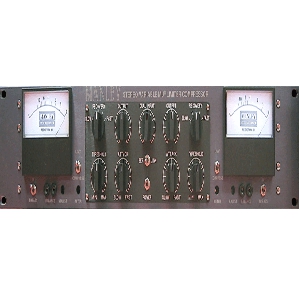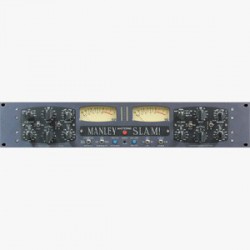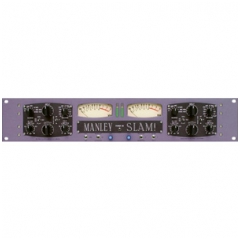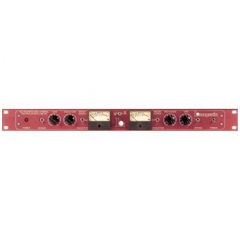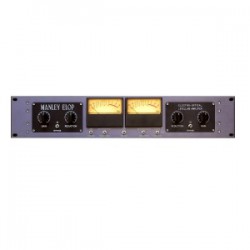Danh mục tin
The MANLEY VARIABLE MU® LIMITER COMPRESSORhas been our best selling product for many years. It is one of the very few compressors that has become a real standard in Mastering studios and contributed to most hit records over the last decade and probably the next. "Mu" is tube-speak for gain, and Variable Mu® is our registered trademark for this limiter compressor. It works by using the "remote cut-off" or re-biasing of a vacuum tube to achieve compression. The precious vintage Fairchild 670 also uses this technique and is one of few all-tube compressor to do so, that we know of. Even the side-chain has glowing rectifier bottles. How’s it work? The unique 5670 dual triode is at the center of the peak-reducing and compression action constantly being re-biased by the vacuum tube rectified side-chain control voltages which cause this tube to smoothly change its gain. Just like that.
The COMPRESS mode is soft-knee 1.5 to 1 ratio while the sharper knee LIMIT mode starts at 4 to 1 and moves to a more dramatic ratio of 20 to 1 when limiting over 12dB. Interestingly, the knee actually softens as more limiting is used. Distortion can be creatively used by turning up the Input and turning down the Output while using very little or no compression. See the gain reduction curves here!
You might notice that the Variable Mu® Limiter Compressor has a ganged input control, but do not jump to conclusions that it is mono-unfriendly. Track away! There are separate threshold and output controls to make compensations with plus you can always adjust your individual source levels elsewhere, right? The advantage of the stereo input control becomes dramatically clear when you switch to LINK mode, and that’s what our Variable Mu® Limiter Compressor does better than anything else: final mix, 2-track, or mastering limiting and compression. Like one reviewer put it: “It’s like pouring a bowl of sweet cream over the mix.” Mmmmmm. Yummy. Give your music a big hug.
Features and Specifications
- MANLEY input & output transformers with nickel laminations in mu-metal cases with flat frequency response from 20Hz-25KHz
- BALANCED INPUTS & OUTPUTS (600 Ohms)
- Fully differential ALL-TUBE circuitry using one each 5670, 5751, 7044 or 5687, & 12AL5 per channel
- Independently regulated B+ and Heater supplies
- Hard-wire BYPASS switch
- Stepped switch INPUT attenuator as of 10/2011. (older units use Silent dual-ganged potentiometer)
- RECOVERY 5 steps: 0.2s, 0.4s, 0.6s, 4sec., 8sec.
- Variable ATTACK: 25msec-70msec
- Continuously variable THRESHOLD
- LIMIT (4:1 to 20:1) or COMPRESS (1.5 to 1)
- HP SC: High Pass Side Chain Filter -3dB @ 100Hz
- Large ILLUMINATED Sifam METERS (older units before serial number MSLC61642 shipped before 12/2003 use: 26V 1.2W FESTOON LAMPS; Manley's Part Number: VAR016B) Order spare bulbs using our parts order form. (newest units after serial number MSLC61642 shipped after 12/2003 use white LED lighting)
- STEREO LINK SWITCH
- Several units can be linked for Surround (custom order )
- Maximum gain: 35dB
- Max. output: +30dBu (26Vrms) 26dB Headroom
- Power Consumption (120/240VAC): 80 watts
- Unit is factory set for 100V, 120V or 220-240VAC operation for original destination country's mains voltage.
- Operating Mains Voltage changeable with power transformer changeover switch and fuse value change.
- Mains Fuse Value for 100~120VAC operation: replace with 1.25A as of 10/2011
- Mains Fuse Value for 220~240VAC operation: replace with 0.6A (600mA) as of 10/2011
- Mains Fuse Type: MDA or MDL SLO-BLO Time delay 1 1/4" x 1/4"
- Mains Voltage Frequency: 50~60Hz
- Dimensions: 19” x 3 1/2” x 10” (chassis occupies 2u) Power transformer protrudes 3.5" out the back of the chassis.
- Shipping Weight: 23 lbs.
SPECIAL MASTERING VERSIONS AND CUSTOM MODS AVAILABLE TO ORDER
Proudly from our beginning, we at MANLEY LABS have been closely involved with numerous mastering facilities around the world. For these most demanding engineers in our industry, we have created specialized products such as our all-tube tape repro head amps, digital converters, high-powered vacuum tube monitor amplifiers, through to custom monitoring consoles, all the way up to complete facility design and installation.
The Mastering Version of our Variable Mu® Limiter Compressor incorporating detented and logable steps built with 1% metal film resistors on sealed gold-contact Grayhill switches is available. NO, we will not mod a "normal" unit to the Mastering Version.
The switches specifically are like this:
Input: -4 to +4 in 2 dB steps
Output: -11 to 0 in 1/2 dB steps (24 detents)
Threshold: -11 to +1 in 1/2 dB steps (24 detents)
Attack: 11 positions
Release: 5 positions

Mastering Version engraving shown with HP SC Mods.
 The High Pass Side Chain modcomes stock on all Manley Variable Mu limiter/compressors since 12/2009, on both regular and mastering versions. This mod adds two switches to the front panel, one for each channel, so that when engaged, the side chain will not respond to frequencies lower than 100Hz. (We standardly use 100Hz as the -3dB point. Other frequencies can be custom ordered.) This HP SC Mod can be used with music with heavy bass lines or bass-heavy mixes where you don't want the bass driving the whole action of the compressor.
The High Pass Side Chain modcomes stock on all Manley Variable Mu limiter/compressors since 12/2009, on both regular and mastering versions. This mod adds two switches to the front panel, one for each channel, so that when engaged, the side chain will not respond to frequencies lower than 100Hz. (We standardly use 100Hz as the -3dB point. Other frequencies can be custom ordered.) This HP SC Mod can be used with music with heavy bass lines or bass-heavy mixes where you don't want the bass driving the whole action of the compressor.
The filter is a very gentle 6db per octave 1 pole filter, and will typically be down 1-3db at 100 Hz, and down 4-6db at 50Hz. As you decrease the frequency the amount of limiting will decrease also. At the extreme LF (Surround Sound Linking. This presumes you want to use 4 to 6 (or more) channels of Variable Mu for your 5.1 surround work, and you own two or three Stereo Variable Mu units (or more). For this we add a pair of RCA jacks on the back of each unit so that the sidechain can be easily plugged into another one or two other Stereo Variable Mu units. Then the LINK switch is replaced with a three-way switch and wired to select amongst the following three conditions:
LINK: Link the side-chains of the two channels in this chassis
EXT: Link the side-chains of the two channels in this chassis AND to the other units plugged into the RCA linking sidechain access jacks on the back of the unit.
SEP:Do not link to any other channels
We add TWO RCA jacks to each unit for easy daisy-chaining. Just use any ol' RCA cables you have lying around to link up the sidechains.
Then all the sidechains track each other. You still have to set up each unit as you would though, as the very act of linking the side chains does not create a master-slave situation.
We usually charge $200 NET per unit to do this Surround Linking mod.
 We also offer a Mid/Side mod upgrade(aka. Vertical/Lateral or Sum/Difference) to the Variable Mu® Limiter Compressor which opens the door to stereo encoding and decoding as well as exciting image enhancement processing capabilities. For instance, setting to compress only the in-phase information allows the augmentation of the stereo image as the out-of-phase content is left untouched. Or, conversely, if you need a "more-mono" mix for broadcast, or vinyl-cutting for instance, you can set it to kill off more of the out-of-phase info which leaves more in-phase material in the final result. Read more about the MS Mod on page 12 of the Owner's Manual.
We also offer a Mid/Side mod upgrade(aka. Vertical/Lateral or Sum/Difference) to the Variable Mu® Limiter Compressor which opens the door to stereo encoding and decoding as well as exciting image enhancement processing capabilities. For instance, setting to compress only the in-phase information allows the augmentation of the stereo image as the out-of-phase content is left untouched. Or, conversely, if you need a "more-mono" mix for broadcast, or vinyl-cutting for instance, you can set it to kill off more of the out-of-phase info which leaves more in-phase material in the final result. Read more about the MS Mod on page 12 of the Owner's Manual.
Total mod cost for the M-S option is $500 NET added to the base cost.
In order to add both M-S and the HP SC mods, we move the power switch to the rear panel and install both channels' HP SC switch to the center hole where the power switch was. The M-S switches then flank this switch.
Please inquire with us personallyfor detailed information.
Which tubes should I use in my Variable Mu® Limiter Compressor? 6386? 5670? or 6BA6 TBAR Mod?
Yes, the newer units use the 5670 tube instead of the 6386. By now the availability of the original USA GE 6386 is poor; we don't have any left at all, and what we do have are not usable due to noise, microphonics, bad side-to-side match, etc.
Does the 5670 sound different?
Well, up to about 6db of limiting it's about the same. After that point, the 5670 version tends to sound more "squashed" than the original 6386 version. Some like it better, some don't-- depends on what you're trying to do. To solve all these problems, Paul came up with a really good solution: the T-Bar Mod which uses a pair of 6BA6 pentodes wired as single triodes to replace each dual triode 5670 (or 6386). the 6BA6 TBAR Mod is the preferred system to use in the Manley Variable Mu® for reasons of ability to perfectly match each phase-halve section and each stereo set, ability to select for lo-noise and lo-microphonic sets for a low cost, and because the action of the 6BA6's so closely resemble the smooth 6386 limiting curves.
Read more about Paul's special T-Bar Mod here.
Update 2009: There is a new production 6386 being made by JJ factory. They are very expensive, $120 each! We have not tested these tubes.
You can read an informative thread about the JJ6386 on Gearslutz to decide if you want to them instead.
Follow the directions below to convert your 5670-powered Manley Variable Mu® to use the 6386 tubes. It's more work to do this than to install our 6BA6 T-Bar mod kits which we charge $250 for (complete and installed with four 6BA6 tubes selected for quad-perfect matching, lo-noise, and lo-microphonics).
If you want us to convert your unit for you, we can. You'll be supplying the 6386 tubes and we will all pray to the Tube gods that they are quiet and internally matched. Maybe buy extras to be sure. Check out our service page for rates and then fill in the RA form to book the service and you can work with Paul on that.
INSTRUCTIONS FOR CONVERTING 5670 TO 6386
Replace 3K57 resistors connected to pins 4 & 6 of 5670 socket with 6K8 1W. Replace 1K resistors connected to pins 2 and 8 with 511 Ohms. Replace 10K "balance" trimpot with 500 Ohm trimpot. Remove 200 Ohm resistor between pins 2 and 8. Replace 33K 1W resistor between wiper of "GR cal" trimpot and the junction of the meter with 22K 1W (resistor is located near the rear corner of the pcb next to the GR cal trimpot). Repeat procedure for the other channel; re-calibrate as outlined in the owner’s manual.What is the difference between turning up the INPUT level control to drivethe unit into limiting with more level versus using the THRESHOLD control?
The limiting characteristics shouldn't change much, but the distortioncharacteristics will. The input control on these units is located ahead ofthe tubes, directly "behind" the input transformer. So as you advance theinput control, you're hitting the input tube (which is the gain-varyingstage) with more and more signal. Gain reduction is done by making the DCbias on this tube more negative (the threshold control determines how much).The tube has a limit as to how far it can be biased negative to reduce gainbefore it goes non-linear, and since your audio signal is obviouslyswinging both positive and negative, the big swings of the audio signal plusthe negative gain control voltage will eventually push the tube into the redzone. Tubes like the 6386/6BA6/12BA6 can be pushed a lot farther before the THD builds than tubes like a 5670. Higher signal level also pushes the rest of the tubes and the output transformer harder, which will change the sound character as well.
Manufacturer's Suggested Retail Price
- Manley Stereo Variable Mu® Limiter Compressor with HP SC included:
MSLCHP: $4,400 USD - Manley Stereo Variable Mu® Limiter Compressor with HP SC and MS Mod:
MSLCHPMS: $4,900 USD - Manley Stereo Variable Mu® Limiter Compressor with HP SC and TBAR Mod:
MSLCHPTBAR: $4,650 USD - Manley Stereo Variable Mu® Limiter Compressor with HP SC and MS and TBAR Mod:
MSLCHPMSTBAR: $5,150 USD - Manley Mastering Version Stereo Variable Mu® Limiter Compressor with HP SC included:
MMSSLCHP: $5,750 USD - Manley Mastering Version Stereo Variable Mu® Limiter Compressor with HP SC and MS Mod:
MMSSLCHPMS: $6,250 USD - Manley Mastering Version Stereo Variable Mu® Limiter Compressor with HP SC and TBAR Mod:
MMSSLCHPTBAR: $6,000 USD - Manley Mastering Version Stereo Variable Mu® Limiter Compressor with HP SC and MS and TBAR Mod:
MMSSLCHPMSTBAR: $6,500 USD - Retrofit M-S Mod: add $500 NET
- Retrofit T-Bar Mod: add $250 NET
- Retrofit High Pass Side Chain Filter option: add $200 NET
- Retrofit to units older than 10 years old: High Pass Side Chain Filter option: add $275 NET
- **Please note that units older than ten years old are more fragile and fatigued and require extra attention and will usually cost more to work on, generally speaking.
ELOP® Limiter or Variable M® Limiter Compressor? Which one is for me?
You've probably heard someone say, "You've gotta get the Manley compressor." Now you've found out we make two completely different stereo units yet each unit has its own following. (And then there are the fanatics that own both of 'em...) But when you can only get one, the choice really depends on what you need a dynamics processor for. If your requirements include compressing your 2-Buss, drums, or making this your day-to-day compressor, the Variable Mu® Limiter Compressor is your clear choice. Why? Because when used more than a few dB, the ELOP® Limiter's fast attack time will want to grab fast transients first (like drums) from a mix and throw them back into the next room behind the speakers. The Variable Mu® Limiter Compressor has adjustable attack and release which have optimised settings for mixing and mastering but are flexible enough and also go fast enough for most tracking situations. This makes the Variable Mu® Limiter Compressor one truly versatile machine.
You might think having every control in the world is what you need, but if recording vocals is your main focus or if you're doing live work, your goal is to be ready not to miss 'that moment'. The ELOP® Limiter is ideal for recording and tracking because it is incredibly easy to use, and hard to get it wrong. It seems to do the right thing at the right time-- no regrets. Peak limiting of individual instruments especially vocals, room mics on drums, and good ol' mega-squashing effects are the daily duties of the ELOP® Limiter.
The most common mistake most people make when buying a compressor is getting wrapped up in specs and theory. Remember, that the real goal is cool music and great sounds, not knobs and numbers. Time to stop thinking and start listening!
You might also consider some of our other limiters and compressors:
READ ME: WHICH LIMITER SHOULD I BUY?
Previous versions: Variable Mu® IdentificationGuide.
Manley Variable Mu® Limiter and Compressor (Q & A - taken from real-life emails):
1. Question: My meter lamps burned out. How do I get replacements?
Older units before serial number MSLC#1642 shipped before 12/2003 use: 26V 1.2W FESTOON LAMPS; Manley's Part Number: VAR016B Order these spare bulbs using our parts order form.Newest units after serial number MSLC#1642 shipped after 12/2003 use white LED lighting and those shouldn't burn out.You can get in touch with Paul in our service department and upgrade your older unit to LED lighting for $25 bucks.
If you are not sure what you have: The incandescent lamps are yellow-ish in color. The LED lamps are blue-ish white in color.
2. I'm thinking to buy a Variable Mu® compressor and I need to know if the mastering version differs from standard version only in this parts? 1% metal film resistors on sealed gold-contact Grayhill switches.
Yes, that is correct. The controls on the Mastering Version are switches instead of smooth pots. Note that the RANGE of operation is less on MASTERING version, and the ATTACK times go slower because it is a dedicated Mastering Unit.
2a. But can I use Variable Mu® mastering version for recording/tracking voices, drums, guitars, strings, etc.......?
Yes, but note that the RANGE of operation is less on MASTERING version, and the ATTACK times go slower because it is a dedicated Mastering Unit. Therefore it might be advised to stay with the regular version if you expect it to be fully versatile for all jobs tracking, mixing, mastering. Many mastering engineers use regular version anyway.
EveAnna says, "If you own a microphone then you are not a mastering engineer."
2b. Question: Do you also put some extra markings around the Mastering Versionknobs in order to make it look more "dense" or is it just more "clicks" with the same markings?
Yes, Extra markings, custom engraved. We generally label each dB step and use aline for the 1/2 dBs between. It's easy and clear.
You can see a hi-res picture of the mastering version here.
Mastering Version Variable Mu® shown with the HP SC Mod
3. Question: What's the Deal with ATTACK times?
Hi, I am considering purchasing a Variable Mu® Limiter Compressor (albeit sometime in the distant future when I've saved the cash). Anyway, I know that attack times for tube designs tend to be quite slow. However, the quoted attack times for the Variable Mu® Limiter Compressor in your brochure (25ms - 75ms) seem particularly slow. Orleast when compared to the times I've seen quoted for most other compressors(including optical and variable-gain devices like the EAR 660). Am I rightin thinking that the attack times for the Variable Mu® Limiter Compressor were measured for the compressor to achieve a predetermined amount the gain reduction? Is it likely that some of the other compressors' attack times that I've seen arebased on the time taken for the onset of compression instead of a set amountof GR.
I would also like to take this opportunity to ask if you are familiarwith the Cranesong STC-8 Compressor. I am currently using one of these asmy only compressor and am interested to know how/or if the Variable Mu® Limiter Compressorwill complement it. The STC-8 is a firm favourite of mine for bass and I aslolike it on vocals. I would mainly like to use another compressor (i.e. theVariable Mu® Limiter Compressor) for hip-hop/house/funk style drums, both individually andsub-mixed. So the range of attack times are of particular interest to me. Ihave no real interest in mastering or compressing my finally mixes. Obviously it would be easiest for me to just listen to one. However, nolocal shops have demo units and it wouldn't be fair to ask them to get onein for me to listen to until I have the cash.
Any info you can give me would be much appreciated.
Cheers,
Ben Williams
Answer from Hutch:
Hi Ben
I can try to answer your questions, but there are not really pat answers.Bottom line, you just have to try it and find out if it works for you.
1) The way the Variable Mu® Limiter Compressor is designed, each release setting uses a different capacitor, which means attack is release dependent.
2) Dave Collins, the famous mastering engineer measured the timing manyyears ago, without the knowledge of "item 1", and because at the time, hehad an Audio Precision test rig and we didn't. We use his numbers. We arenot sure how he based his measurements, but we assume they are rough at bestand nobody would understand the real numbers anyways.
3) We do not know how other companies base their measurements as there is noreal "standard" to specifions of attack and release times, etc, and it isnot a simple topic except in simple cheesy units. For example both the STC8and Variable Mu® Limiter Compressor use multiple attacks and releases (simultaenously) and ratios tend to be a curve.
4) The STC8 is known as one of the best and fastest dynamics units. Youwon't find much faster or more versatile.
5) With designs similar to the Variable Mu® Limiter Compressor, very fast attacks are related with popsand thumps, so I would take other attack times in similar units with a graino' salt, or understand there has to be non-musical side effects.
6) If you want very fast attack times, the SLAM!® is shipping andshould be appropriate for your needs. We used drum CDs to develop it. Again this uses a complex sidechain with at least 4 time constants in use, so attack and release time ranges won't help you or others come to a conclusion.
7) The Variable Mu® Limiter Compressor is used on more than 90% of mastered music, and tends to simply make music sound better. It is not a generic compressor that can really becompared to anything else, in use or on paper. If it was, it would not be aswidely used as it is, and other compressors would be a valid substitute.
4. Question: I've heard that you may put some different (non standard) tubes in to the Variable Mu® to makeit sound a little thicker in the low end. Tell me about that?
Rumors that the Variable Mu® is somehow lacking in the lows may be tracedback to some outlandish web posters who originally said it to becontroversial, and it was! If one wants to get attention on the web, aproven way is to squawk about the most respected stuff or challenge digitaltheory. Its that or open heated discussions about politics or religion.
Actually, the problem stemmed from operator error in the hands of a guy whois just occasionally an engineer. Most of the recognised mastering engineersuse the Variable Mu® daily, and in all its variations so it can't be that significantof a problem, right? Any box can be pushed to sound bad which is what thebetter engineers avoid. The truth is that the Variable Mu® adds a special flavor to amix that nothing else does, the way that most use it which is just 1 or 2 dBof compression. It still is the standard for mastering after many years.
5. Question: Can you please let me know if that would be of some benefit for mein mastering and what tubes exactly these are? Is it at extra cost?
We have used 3 different tubes in the Variable Mu®, the first one, the 6386, is almost impossibleto get now, the second, 5670, was a reasonable replacement but suffered a bit whenpushed beyond 6 dB of compression, and the third tube type actually uses two tubes toreplace one of the above, but duplicates the original action when pushedhard. So we designed an adapter called the "T-Bar Mod" so that those twotubes just plug into the original socket meant for one tube. We can alsoselect among tubes for best matching. The mod adds $250 to the NET dealer cost.
6. I see an older unit for sale. How do I know which version it is?
Here is the Variable Mu® Identification guide to previous versions.
7. Question: What is the real difference in quality between these and the standard versions?
At normal mastering settings the differences are very subtle, but given thatthe T-Bar mod is not expensive, I do recommend it, especially for theoccasional time when some deep compression is demanded from it. The bestadvice is to experiment with input and output levels once you get the Variable Mu®(including externally) because it is about finding the sweet spot for you.
There is also the "M/S" mod that some mastering guys like and others preferto do in digital.
Manley Variable Mu® gutz 2004 production:


